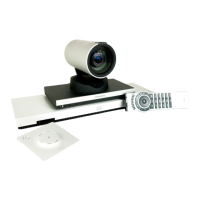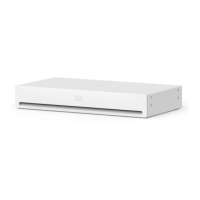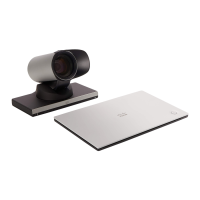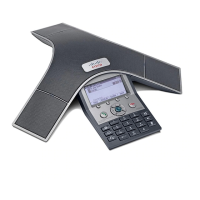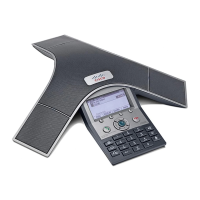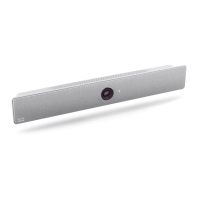35
Cisco TelePresence System Quick Set C20 / C20 Plus and Profiles using C20 Administrator guide
D14637.04 Profile C20 and Quick Set C20 Administrator Guide TC4.0, November 2010.
Copyright © 2010 Cisco Systems, Inc. All rights reserved.
www.cisco.com
Network [1..1] QoS Diffserv Audio
The Diffserv Audio defines which priority Audio packets should have in an IP network. Enter a priority,
which ranges from 0 to 63 for the packets. The higher the number, the higher the priority. These priorities
might be overridden when packets are leaving the network controlled by the local network administrator.
NOTE: Requires the Network QoS Mode to be set to Diffserv.
Requires user role: ADMIN
Value space: < 0..63>
Audio: A recommended value is Diffserv Code Point (DSCP) AF41, which equals the value 34. If in
doubt, contact your network administrator.
Range: Select a value from 0 to 63.
Example: xConguration Network 1 QoS Diffserv Audio: 0
Network [1..1] QoS Diffserv Data
The Diffserv Data defines which priority Data packets should have in an IP network. Enter a priority,
which ranges from 0 to 63 for the packets. The higher the number, the higher the priority. These priorities
might be overridden when packets are leaving the network controlled by the local network administrator.
NOTE: Requires the Network QoS Mode to be set to Diffserv.
Requires user role: ADMIN
Value space: < 0..63>
Data: A recommended value is Diffserv Code Point (DSCP) AF23, which equals the value 22. If in
doubt, contact your network administrator.
Range: Select a value from 0 to 63.
Example: xConguration Network 1 QoS Diffserv Data: 0
Network [1..1] QoS Diffserv Signalling
The Diffserv Signalling defines which priority Signalling packets should have in an IP network. Enter a
priority, which ranges from 0 to 63 for the packets. The higher the number, the higher the priority. These
priorities might be overridden when packets are leaving the network controlled by the local network
administrator. NOTE: Requires the Network QoS Mode to be set to Diffserv.
Requires user role: ADMIN
Value space: < 0..63>
Signalling: A recommended value is Diffserv Code Point (DSCP) AF31, which equals the value 26. If
in doubt, contact your network administrator.
Range: Select a value from 0 to 63.
Example: xConguration Network 1 QoS Diffserv Signalling: 0
Network [1..1] QoS Diffserv Video
The Diffserv Video defines which priority Video packets should have in an IP network. Enter a priority,
which ranges from 0 to 63 for the packets. The higher the number, the higher the priority. These priorities
might be overridden when packets are leaving the network controlled by the local network administrator.
NOTE: Requires the Network QoS Mode to be set to Diffserv.
Requires user role: ADMIN
Value space: < 0..63>
Video: A recommended value is Diffserv Code Point (DSCP) AF41, which equals the value 34. If in
doubt, contact your network administrator.
Range: Select a value from 0 to 63.
Example: xConguration Network 1 QoS Diffserv Video: 0
Network [1..1] DNS Server [1..5] Address
Define the network addresses for DNS servers. Up to 5 addresses may be specified. If the network
addresses are unknown, contact your administrator or Internet Service Provider.
Requires user role: ADMIN
Value space: <S: 0, 64>
Format: String with a maximum of 64 characters.
Example: xConguration Network 1 DNS Server 1 Address: ""
Network [1..1] DNS Domain Name
DNS Domain Name is the default domain name suffix which is added to unqualified names.
Example: If the DNS Domain Name is "company.com" and the name to lookup is "MyVideoSystem", this
will result in the DNS lookup "MyVideoSystem.company.com".
Requires user role: ADMIN
Value space: <S: 0, 64>
Format: String with a maximum of 64 characters.
Example: xConguration Network 1 DNS Domain Name: ""
Network [1..1] IEEE8021X Mode
The system can be connected to an IEEE 802.1X LAN network, with a port-based network access control
that is used to provide authenticated network access for Ethernet networks.
Requires user role: ADMIN
Value space: <On/Off>
On: The 802.1X authentication is enabled.
Off: The 802.1X authentication is disabled (default).
Example: xConguration Network 1 IEEE8021X Mode: Off
The Network settings, continued... The Network settings, continued...
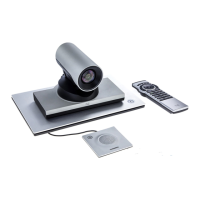
